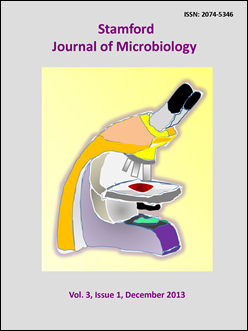Screening of antimicrobial potential and brine shrimp lethality bioassay of the whole plant extract of Spilanthes paniculata Wall. ex DC
DOI:
https://doi.org/10.3329/sjm.v3i1.22743Keywords:
Spilanthes paniculata, Antimicrobial activity, Brine shrimp lethality, Cytotoxicity, LC50Abstract
Bangladesh possesses a rich flora of medicinal plant. Out of the estimated 5000 species of phanerogams and pteridophytes growing in this country, more than a thousand are regarded as having medicinal properties. The aim of this study was to evaluate the in vitro antimicrobial activity and brine shrimp lethality of the whole plant extracts of Spilanthes paniculata, a plant belonging to the family Asteraceae. The crude extract, n-Hexane, chloroform and ethyl acetate soluble fraction of crude extract showed significant to moderate antimicrobial activity against three Gram positive and three Gram negative microorganisms. The zones of inhibition produced by the crude extract (methanolic extract), n-hexane, choloform and ethyl acetate soluble fractions were found to be 14.89 mm-19.40 mm, 14 mm-19.40 mm, 10.66 mm-13.50 mm and 9.50 mm-13.26 mm, consecutively at a concentration of 30 µg/disc. N-Hexane, chloroform and ethyl acetate soluble fractions of methanolic extract of Spilanthes paniculata were screened for antitumor properties using brine shrimp lethality bioassay. From the results of the brine shrimp lethality bioassay, it can be well predicted that n-hexane, chloroform and ethyl acetate soluble fractions of methanolic extract possess mild cytotoxicity on shrimp naupalii. The median lethal concentration (LC50, the concentration at which 50% mortality of brine shrimp nauplii occurred) of n-hexane, chloroform and ethyl acetate were 48.978 mg/ml, 92.61 mg/ml and 216.770 mg/ml, respectively, comparison with positive control vincristine sulphate with 0.839 mg/ml.
DOI: http://dx.doi.org/10.3329/sjm.v3i1.22743
Stamford Journal of Microbiology, Vol.3(1) 2013: 1-5
Downloads
184
237

